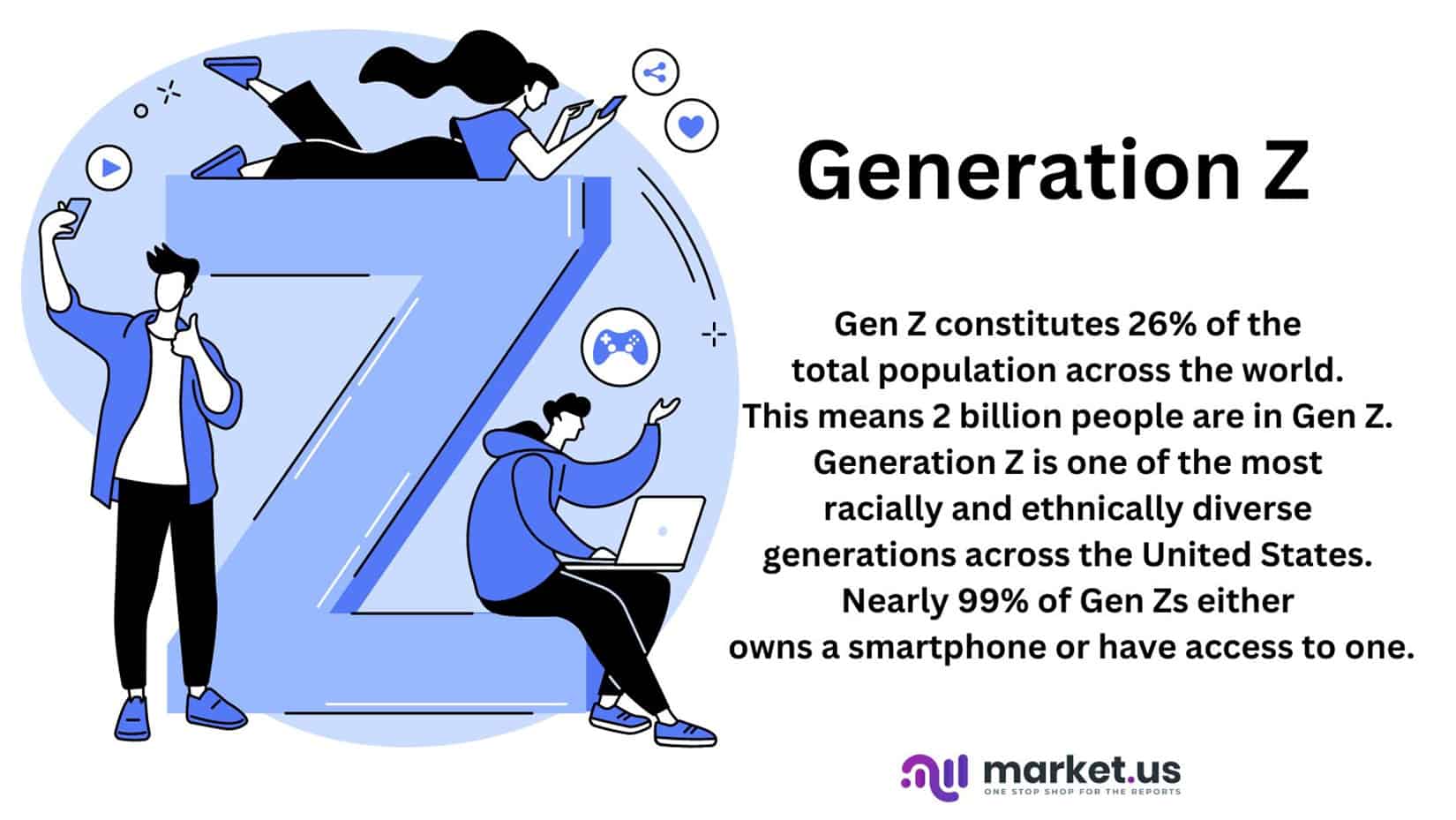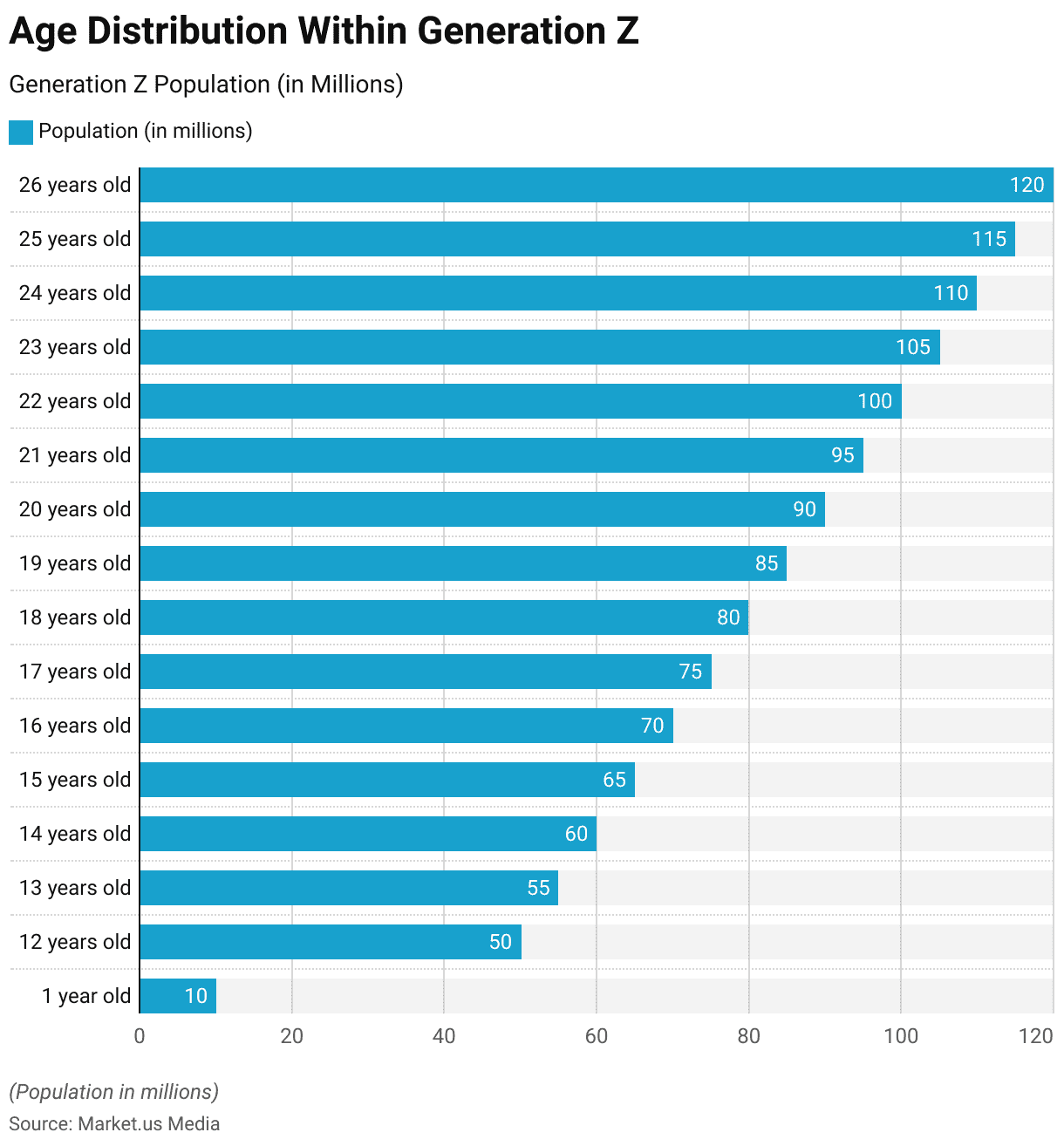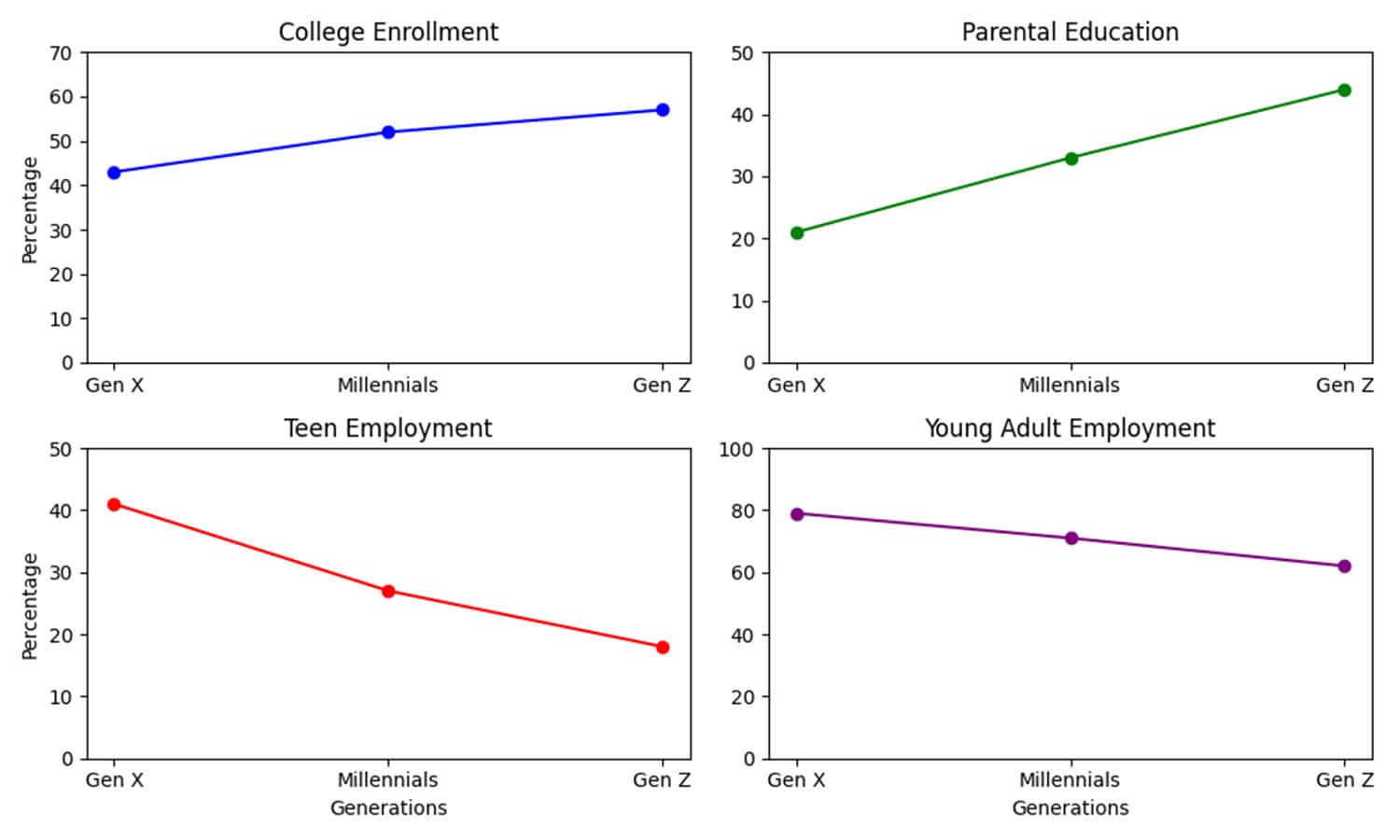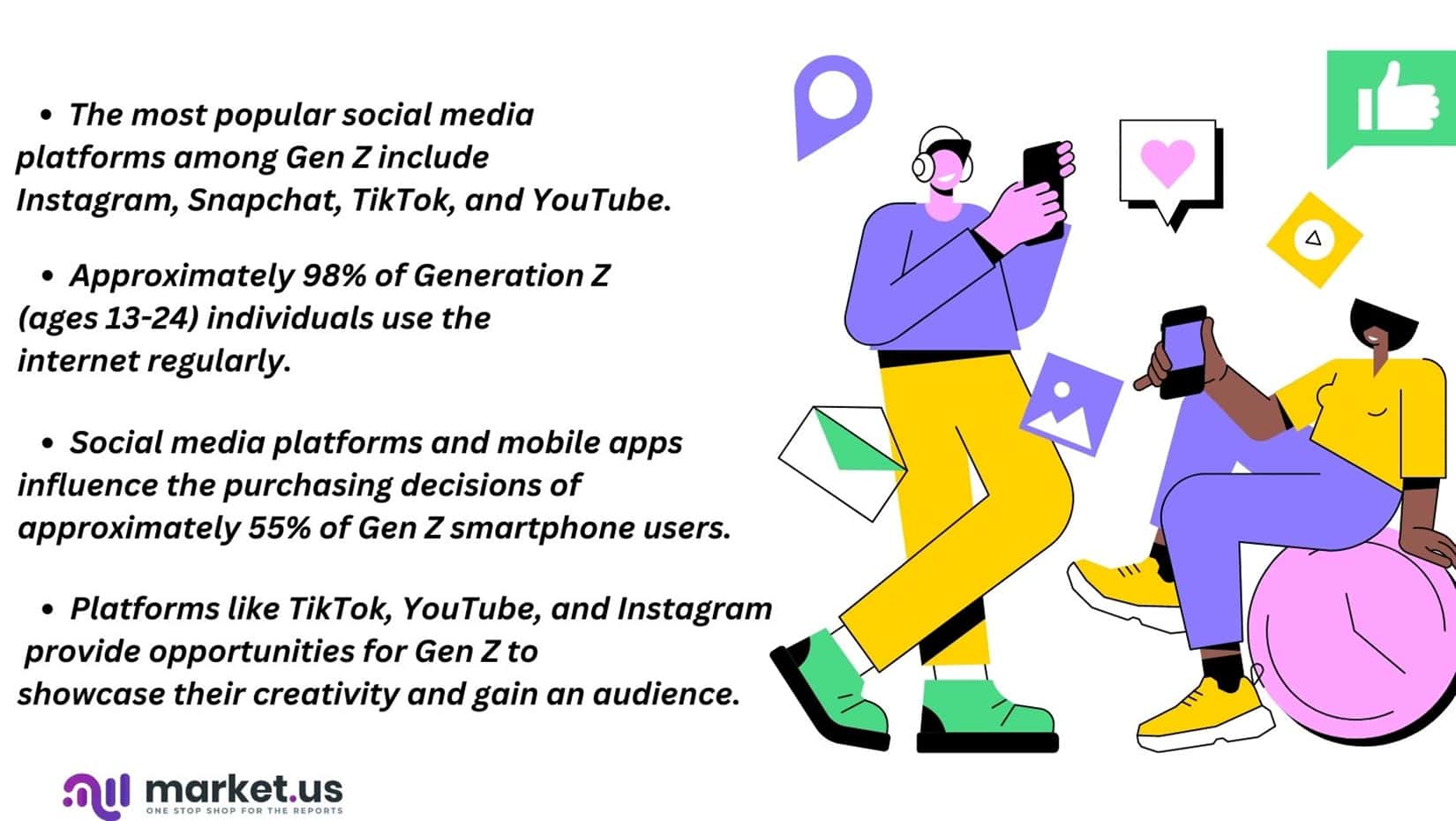Gen Z Statistics: Generation Z, often referred to as Gen Z, is the demographic cohort that follows the millennials and is generally defined as the generation born between the mid-1990s and the early 2010s.
While there is no universally agreed-upon timeline for exact birth years, Gen Z is typically considered to include individuals born from around 1995 to 1010.

Table of Contents
- Curator’s Choice
- General Generation Z Statistics
- Gen Z Statistics – Population Size and Age Distribution
- Racial and Ethnic Composition
- Gen Z Statistics – Education and Employment Trends
- Gen Z Statistics – Internet and Social Media Use
- Gen Z Statistics – Smartphone Ownership
- Gen Z Statistics – Online Activities
- Social and Political Views of Gen Z Statistics
- Gen Z Statistics – Shopping Habits
- Gen Z Statistics – Brand Preference
- Gen Z Statistics – Health and Well-being
- Generation Z Statistics by Country
- Recent Developments
- Wrap Up
- FAQs
Curator’s Choice
- The Behavioral Health Market size is expected to be worth around USD 227.5 Bn by 2032 from USD 140.1 Bn in 2022, growing at a CAGR of 5.1% during the forecast period from 2022 to 2032.
- Generation Z comprises approximately 26% of the global population.
- The birth years for Generation Z typically range from the mid-1990s to the early 2010s. However, there is no universally agreed-upon definition for the exact birth year range.
- Generation Z is the most racially and ethnically diverse generation in the United States, with 48% being non-white.
- Around 95% of Generation Z owns or has access to a smartphone, making them the first truly “digital native” generation.
- Generation Z is highly active on social media platforms, with 98% of individuals aged 18-24 using at least one social media platform regularly.
- In terms of education, 59% of Generation Z plans to pursue a college degree.
- Approximately 61% of Generation Z is concerned about the environment and believes that companies should take more action to address climate change.
- Mental health issues are a significant concern for Generation Z, with 91% reporting experiencing symptoms of stress and anxiety.
(Source: Pew Research Center, Statista, McKinsey & Company, American Psychological Association)
General Generation Z Statistics
- There are currently 68.6 million Generation Zs living in the US.
- 64% use Instagram at least once daily.
- climate change is Gen Z’s greatest fear and they are more likely than other generations to seek therapy or mental health services for treatment.
- Over one-third of social media influencers belong to Generation Z.
- 40% of Gen Zs say they plan on leaving their job within the next two years.
- Gen Z will become the majority non-white by 2026 in the US.
- 44% of Gen Zs grew up living with parents holding bachelor’s degrees or higher by 2019 compared to only 33% of millennials in 2003.
- over a third are either employed (part- or full-time), self-employed, or students; 51% still attend school full-time and are 51% still students.
- With many postponing parenthood in life, only 11% have married or had children before entering adulthood.
- 55% of Generation Zs say they are extremely interested in environmental issues.
- 36% of Gen Zs were involved in some form of political activism in 2020.
- Generation Z is the largest generational cohort, comprising approximately 32% of the global population.
- The global population of Generation Z is estimated to be around 2 billion people.
(Source: Exploding topics, Bloomberg, United Nations)
Gen Z Statistics – Population Size and Age Distribution
- Generation Z is generally defined as individuals born between the mid-1990s and the early 2010s.
- The birth year range for Generation Z is commonly considered to be from 1997 to 2012.
- As of 2023, the current age range for Generation Z is approximately 11 to 26 years old.
- The age distribution within Generation Z varies based on the specific year and region. However, a rough estimate suggests that the majority of Generation Z individuals would fall within the 15 to 24 age group.
- The global population of Generation Z is estimated to be around 2 billion people.
- In the United States, Generation Z is estimated to have a population of approximately 67 million as of 2021.
- Generation Z makes up a significant portion of the global and national populations. In many countries, they represent around 25% to 30% of the total population.
(Source: Pew Research Center)

Racial and Ethnic Composition
- 52% of Generation Z individuals are non-Hispanic white.
- 25% of Generation Z individuals are Hispanic.
- 14% of Generation Z individuals are black.
- 6% of Generation Z individuals are Asian.
- 5% of Generation Z individuals identify as some other race or belong to two or more races.

Immigrant Status
- 6% of Generation Z individuals were born outside of the United States.
- 22% of Generation Z individuals have at least one immigrant parent.
Regional Breakdown
- In the West region, 40% of Generation Zers are non-Hispanic white, while an equal percentage identify as Hispanic. Additionally, 4% are black, 10% are Asian, and 6% identify as some other race.
- In the South region, 46% of Generation Zers are non-Hispanic white.
- In the Midwest region, 68% of Generation Zers are non-Hispanic white.

Gen Z Statistics – Education and Employment Trends
Education
- Among 18- to 21-year-olds who were no longer in high school in 2022, 57% of Generation Z were enrolled in a two-year or four-year college.
- In comparison, 52% of Millennials in 2003 and 43% of Generation X in 1987 were enrolled in college at the same age.
- Second-generation Hispanic youth within Generation Z are less likely to drop out of high school and more likely to attend college than foreign-born Hispanic youth.
(Source: Pew Research Center)
Parental Education
- In 2019, 44% of Generation Zers ages 7 to 17 were living with a parent who had a bachelor’s degree or higher education.
- This is higher than the 33% of Millennials who had a parent with a bachelor’s degree or higher when they were the same age.
(Source: Pew Research Center)
Employment
- Among Gen Z teens (ages 15 to 17) in 2021, only 18% were employed.
- In comparison, 27% of Millennial teens in 2002 and 41% of Gen Xers in 1986 were employed at the same age.
- Among young adults ages 18 to 22, 62% of Generation Z were employed in 2022. This is lower than the employment rates of 71% for Millennials and 79% for Gen Xers when they were a comparable age.
(Source: Pew Research Center)

Gen Z Statistics – Internet and Social Media Use
- Approximately 98% of Generation Z (ages 13-24) individuals use the internet regularly.
- On average, Gen Z spends about 6 hours and 40 minutes online each day.
- Popular online activities among Gen Z include social media, streaming videos, online gaming, and browsing the web.
- Gen Z is the most active generation on social media, with around 90% having at least one social media account.
- The most popular social media platforms among Gen Z include Instagram, Snapchat, TikTok, and YouTube.
- Gen Z individuals spend an average of 2 hours and 55 minutes per day on social media platforms.
- Instagram is the preferred social media platform for brand discovery and product research among Gen Z, with 80% of users following at least one brand.
- Around 45% of Gen Z individuals have taken steps to protect their online privacy, such as using private browsing or clearing their browser history.
- Gen Z is more likely to prioritize platforms that prioritize privacy and data security.
- Cyberbullying is a significant concern for Gen Z, with around 59% reporting having witnessed someone being bullied online.
(Source: Pew Research Center, GlobalWebIndex, Kantar, IBM, National Research Group)
Gen Z Statistics – Smartphone Ownership
- Approximately 97% of Generation Z individuals (ages 13-24) own a smartphone.
- Among Gen Z smartphone owners, 84% consider their smartphone as their most important device.
- The most popular smartphone brands among Gen Z are Apple (iPhone) and Samsung.
- Apple iPhones are particularly popular among Gen Z, with around 85% of Gen Z individuals owning an iPhone.
- Gen Z spends an average of 4.5 hours per day on their smartphones.
- The top activities on smartphones for Gen Z include social media usage, messaging, streaming music and videos, gaming, and accessing educational content.
- Gen Z heavily relies on their smartphones for product research and purchasing decisions. Around 65% of Gen Z smartphone users conduct product research on their devices before making a purchase.
- Social media platforms and mobile apps influence the purchasing decisions of approximately 55% of Gen Z smartphone users.
(Source: GlobalWebIndex, Piper Sandler, Pew Research Center)
Gen Z Statistics – Online Activities
- Approximately 98% of Gen Z individuals (ages 13-24) use at least one social media platform.
- Instagram is the most popular social media platform among Gen Z, with around 76% of users aged 13-17 using it.
- Snapchat is also highly popular among Gen Z, with about 73% of users aged 13-24 using it.
- TikTok has seen significant growth among Gen Z, with approximately 68% of users aged 18-24 using it.
- YouTube is a primary source of video content for Gen Z, with 95% of individuals aged 13-24 using the platform.
- Gen Z spends an average of 2 hours and 55 minutes per day watching online videos.
- Short-form video platforms like TikTok and Instagram Reels are also popular, with about 60% of Gen Z using these platforms.
- Gaming is a prevalent online activity among Gen Z, with about 87% of individuals aged 13-24 engaging in gaming regularly.
- Multiplayer online games like Fortnite, Call of Duty, and League of Legends are highly popular among Gen Z gamers.
- Esports, competitive gaming events, and live streaming platforms like Twitch have gained significant popularity among Gen Z.
- Gen Z is actively involved in content creation, with approximately 58% of individuals aged 13-24 creating and sharing their videos online.
- Platforms like TikTok, YouTube, and Instagram provide opportunities for Gen Z to showcase their creativity and gain an audience.
(Source: Pew Research Center, Think with Google, Entertainment Software Association, Nielsen, GlobalWebIndex)

Social and Political Views of Gen Z Statistics
Social Issues
- A survey found that 78% of Gen Z respondents are concerned about climate change and its impact on the planet.
- Approximately 72% of Gen Z individuals believe that same-sex couples should have the right to marry.
- A study revealed that 76% of Gen Z respondents believe that racial discrimination is a significant issue in society.
(Source: Pew Research Center)
Political Affiliation
- Gen Z tends to lean more toward progressive and liberal ideologies. Around 61% of Gen Z respondents identify as Democrats or lean Democratic.
- Approximately 10% of Gen Z individuals identify as independent voters, demonstrating a desire for non-partisanship.
- Gen Z is actively engaged in political issues, with 57% reporting that they have taken part in a protest or rally for a cause they care about.
(Source: Pew Research Center)
Activism and Social Movements
- A survey showed that 70% of Gen Z supports the Black Lives Matter movement and its objectives.
- According to a study, 69% of Gen Z individuals believe that there should be stricter gun control laws in the United States.
- An analysis revealed that 76% of Gen Z believe that gender equality is important and that society should do more to achieve it.
(Source: Pew Research Center)
Gen Z Statistics – Shopping Habits
- 81% of Gen Zers conduct online research before making a purchase.
- 85% of Gen Zers read reviews before making a purchase decision.
- 62% of Gen Zers prefer to see reviews from people they know or trust.
- 70% of Gen Zers use their smartphones for shopping.
- 62% of Gen Zers are comfortable with mobile-only checkouts.
- 51% of Gen Zers have made a purchase directly through a social media platform.
- 72% of Gen Zers prefer to shop in physical stores.
- 80% of Gen Zers like to see, touch, and try products before purchasing.
- 47% of Gen Zers are more likely to buy a product if they can personalize it in-store.
- 66% of Gen Zers have made a purchase based on a recommendation from a social media influencer.
- 63% of Gen Zers follow influencers on social media to discover new products.
- 59% of Gen Zers say that they trust influencers more than traditional celebrities.
- 67% of Gen Zers say that discounts and promotions influence their purchasing decisions.
- 60% of Gen Zers are more likely to purchase from a brand that supports causes they care about.
- 50% of Gen Zers believe it is important for brands to take a stand on social issues.
(Source: IBM, Morning Consult, IBM, Forbes)
Gen Z Statistics – Brand Preference
- 91% of Gen Zers believe that authenticity in brands is important.
- 67% of Gen Zers prefer brands that are authentic and transparent.
- 52% of Gen Zers trust influencers more than traditional celebrities when it comes to brand recommendations.
- 70% of Gen Zers believe companies should take a stand on social issues.
- 61% of Gen Zers are more likely to support a brand that aligns with their values.
- 55% of Gen Zers prefer to buy from brands that are committed to making a positive social or environmental impact.
- 83% of Gen Zers believe it is important for brands to be diverse in their advertising.
- 64% of Gen Zers expect brands to showcase diversity and inclusion in their marketing campaigns.
- 62% of Gen Zers are more likely to support brands that feature people from diverse backgrounds in their ads.
- 81% of Gen Zers are concerned about the environment and believe that individuals should take action to address environmental issues.
- 73% of Gen Zers are willing to pay more for products that are sustainable and environmentally friendly.
(Source: Forbes, Morning Consult, Wunderman Thompson, Morning Consult, McKinsey, IBM)
Gen Z’s Sustainable and Ethical Consumption
- 70% of Gen Zers believe that companies should take a stand on environmental issues even if it means a potential decrease in profits.
- 73% of Gen Zers are willing to change their consumption habits to reduce their impact on the environment.
- 66% of Gen Zers are more likely to support brands that are committed to social and environmental causes.
- 58% of Gen Zers consider a company’s social and environmental commitments when deciding what to buy.
- 79% of Gen Zers say that they actively recycle.
- 76% of Gen Zers say they are concerned about the amount of waste produced by packaging.
- 65% of Gen Zers actively seek out products with minimal packaging.
- 60% of Gen Zers are open to buying secondhand or used products.
- 40% of Gen Zers have shopped at a thrift store in the past year.
- 30% of Gen Zers plan to increase their spending on secondhand fashion in the future.
(Source: Cone Communications, McKinsey, BBMG, IBM, World Packaging Organisation)
Gen Z Statistics – Health and Well-being
Mental Health
- 1 in 3 Gen Zers has been diagnosed with an anxiety disorder.
- 71% of Gen Zers have reported symptoms of stress or anxiety.
- 37% of Gen Zers have experienced symptoms of depression.
(Source: American Psychological Association)
Physical Health
- 75% of Gen Zers engage in regular exercise or physical activity.
- 24% of Gen Zers report fair or poor physical health.
- 20% of Gen Zers report having a chronic health condition.
(Source: McKinsey)
Substance Use
- 31% of Gen Zers have reported using alcohol in the past month.
- 20% of Gen Zers have reported using marijuana in the past month.
- 7% of Gen Zers have reported misusing prescription drugs in the past year.
(Source: exploding topics)

Generation Z Statistics by Country
United States
- Generation Z (born between 1997 and 2012) represents approximately 25% of the U.S. population.
- 98% of Gen Zers in the U.S. own a smartphone.
- 85% of Gen Zers in the U.S. use YouTube regularly.
- 79% of Gen Zers in the U.S. use Instagram regularly.
- 70% of Gen Zers in the U.S. lean towards the Democratic Party or identify as Democrats.
- 62% of Gen Zers in the U.S. believe that racial and ethnic diversity makes the country stronger.
- 61% of Gen Zers in the U.S. say that government should do more to solve problems.
- 50% of Gen Zers in the U.S. plan to attend a four-year college.
- 35% of Gen Zers in the U.S. are employed, with 70% working part-time jobs.
- 37% of Gen Zers in the U.S. are financially independent from their parents.
- 5% of Gen Zers in the U.S. are non-white.
- 70% of Gen Zers in the U.S. believe that gender does not define a person as much as it used to.
(Source: Pew Research Center)
China
- Approximately 260 million Gen Z individuals in China.
- Gen Z is expected to make up around 27% of China’s total population by 2025.
- Gen Z is projected to account for 40% of overall consumption in China by 2020.
- Around 50% of Gen Z in China are expected to hold university degrees.
- 47% of Chinese Gen Z consumers reported buying products on the go, indicating a higher level of impulsiveness compared to their peers in other countries.
- 78% of Chinese Gen Z respondents expressed confidence that they will earn more in the future, contributing to their impulsive spending behavior.
- 36% of the surveyed Chinese Gen Z consumers admitted to overspending their budget, potentially driven by their impulsive nature and optimistic outlook on future earnings.
- Only 21% of Chinese Gen Z respondents stated that they would be relieved if they could pay off all their debts, indicating a relatively higher comfort level with owing money compared to Chinese Millennials.
(Source: Chozan, McKinsey)
India
- In 2021, millennials and Gen Z accounted for 52% of India’s total population, surpassing the global average of 47%.
- By 2030, the share of India’s Gen Z and Millennial population is expected to reach 50%, remaining higher than the global average of 46%.
- Indian millennials have higher stress and anxiety levels (49%) compared to the global average (41%).
- Indian Gen Z individuals experience similar levels of anxiety and stress (46%) as the global average.
- Notably, physical/medical health is a major driver of stress for Indian millennials, with 48% expressing higher concern compared to the global average of 33%.
(Source: Business-standard, Deloitte)
Indonesia
- Generation Z (born between 1997 and 2012) accounted for approximately 32% of Indonesia’s total population.
- Around 90% of Indonesian Generation Z members have access to the internet, with a significant portion using smartphones as their primary device for online activities.
(Source: Statista, Deloitte)
Recent Developments
Market Research and Insights:
- Research firms conducted surveys and studies to understand Gen Z demographics, preferences, and behaviors in various industries, providing insights for businesses and marketers.
- Reports indicated that Gen Z is the most diverse and digitally savvy generation, with a strong preference for authenticity, social responsibility, and personalized experiences.
Digital Engagement and Social Media Trends:
- Gen Z’s use of social media platforms continued to evolve, with a preference for visually appealing content, short-form videos, and interactive storytelling formats.
- Brands launched influencer marketing campaigns targeting Gen Z audiences on platforms like TikTok, Instagram, and Snapchat to drive engagement and brand awareness.
E-commerce and Online Shopping Habits:
- Gen Z’s purchasing behavior shifted towards online shopping, with a preference for mobile-friendly e-commerce platforms and seamless checkout experiences.
- Direct-to-consumer (DTC) brands gained popularity among Gen Z consumers for their authentic brand storytelling, sustainable practices, and personalized product offerings.
Sustainability and Social Responsibility:
- Gen Z expressed a strong interest in sustainability and ethical consumption, driving demand for eco-friendly products, transparent supply chains, and brands that align with their values.
- Companies responded by launching sustainable product lines, implementing green initiatives, and communicating their corporate social responsibility efforts to resonate with Gen Z consumers.
Entrepreneurship and Side Hustles:
- Gen Z showed a growing interest in entrepreneurship and side hustles, with many starting their businesses, freelance gigs, or creative projects alongside traditional employment.
- Online platforms and marketplaces provided opportunities for Gen Z to monetize their skills and hobbies, such as content creation, graphic design, and e-commerce ventures.
Education and Career Preferences:
- Gen Z placed a high value on education and professional development, seeking flexible learning options, career mentorship, and opportunities for skill acquisition.
- Remote work and gig economy opportunities appealed to Gen Z’s desire for work-life balance, autonomy, and flexibility in their careers.
Political and Social Activism:
- Gen Z demonstrated a strong interest in political and social activism, advocating for issues such as climate change, racial justice, LGBTQ+ rights, and gun control.
- Social media platforms served as catalysts for activism and social movements, enabling Gen Z to amplify their voices, mobilize communities, and effect change.
Wrap Up
Gen Z Statistics – Gen Z, born between the mid-1990s and early 2010s, represents a dynamic and influential cohort that is shaping the future in various ways.
This tech-savvy generation has grown up in a digital age, embracing technology and social media as integral parts of their lives.
With a strong emphasis on individuality, inclusivity, and social justice, Gen Z is unafraid to challenge the status quo and fight for meaningful change.
As the torchbearers of the future, Gen Z will continue to make a significant impact on society, driving innovation, promoting equality, and shaping a more inclusive and sustainable world for generations to come.
FAQs
Generation Z, often referred to as Gen Z, is the demographic cohort that follows the Millennials (Generation Y). While there is no universally accepted start and end date for this generation, it is commonly defined as those born between the mid-1990s and the early 2010s.
The exact size of the Gen Z population may vary depending on the source and the specific time frame used. However, it is estimated that Gen Z is the largest generational cohort, surpassing even the Baby Boomers. In the United States, Gen Z is estimated to comprise around 25% of the population.
Discuss your needs with our analyst
Please share your requirements with more details so our analyst can check if they can solve your problem(s)



